The art of being Diaguita
- A little history
- Chino Dances
- Ways of “being Diaguita before the Inka period
- The origins of Diaguita art and culture can be found in Las Ánimas
- Several ceramic styles coexisted in the Norte Chico, representing different modes of “being Diaguita”. One of these was the Fourth Style.
- Like many pre-Hispanic peoples, the Diaguita felt a need to represent themselves in their ceramics
- Color was not the only way in which the Diaguita expressed their identity
- Diaguita ceramics exhibiting bird, feline and reptile faces
- Diaguita tricolor vessels and their shamanic geometries
- Identities in transformation
- The textiles of the Angualasto culture give us an idea of how their Chilean contemporaries, the Diaguita, dressed.
- Objects found in graves prove that Diaguita identity transcended death
- The Diaguita also had fertility cults
- Sounds and melodies accompanied Diaguita ceremonies and rituals
- Shamanic trance played a central role in “being Diaguita”
- By consuming hallucinogenic substances, certain individuals acquired the identity and powers of their guardian animals
- Ways of “being Diaguita” in Inka times
- After the Inka conquest, the Diaguita modified some elements of their culture
- The Diaguita served as agents of the Empire during the Inka expansion into Chile’s Central Valley
- As allies of the Inkas, the Diaguita helped with the administration of the Copiapó Valley
- The Diaguita and the “red metal”
- The Diaguita’s emblematic stone fascinated the Inkas
- The Norte Chico today: Diaguita, in their own way
- Epilogue
- Créditos
The Norte Chico today: Diaguita, in their own way
In one way or another, many inhabitants of Chile’s Norte Chico continue to express today what it means to “be Diaguita”. The videos in this room explore a number of these 21st-century Diaguita identitities.
“Excerpt from “Ternura”, by G. Mistral”
“[…]
Where the accorn grew,
the growing wheat.
And, instead of vicunas,
young bulls atop one another.
Back to your Pachacamac!
A pointless return.
Mad, new-born Indian.
Oh losely bird!”
Gabriela Mistral: Tenderness, 1924.
Traducción Armando Uribe




































